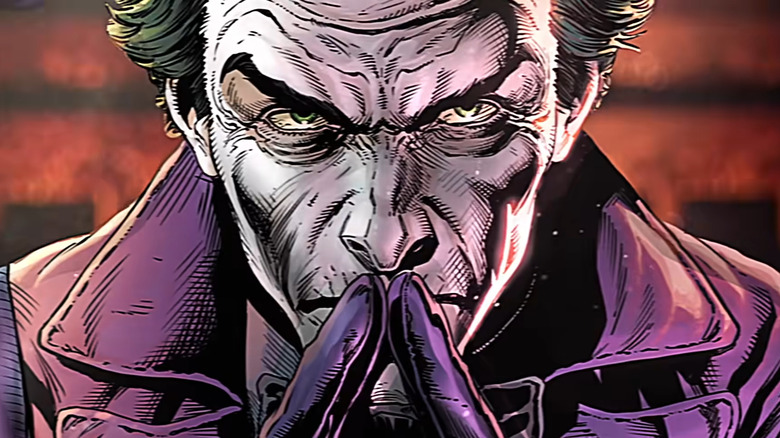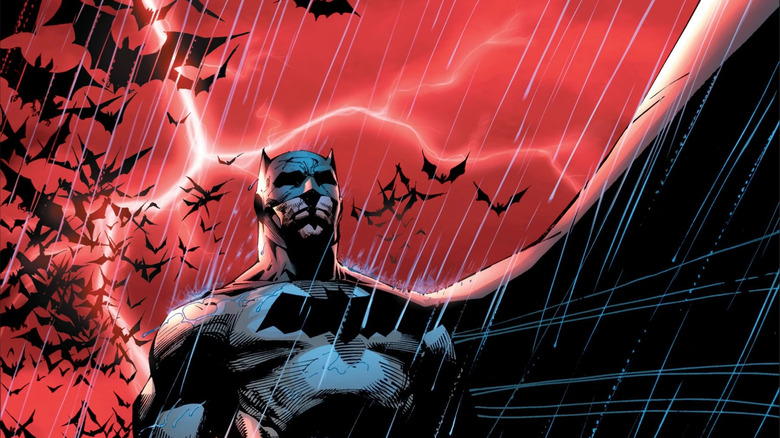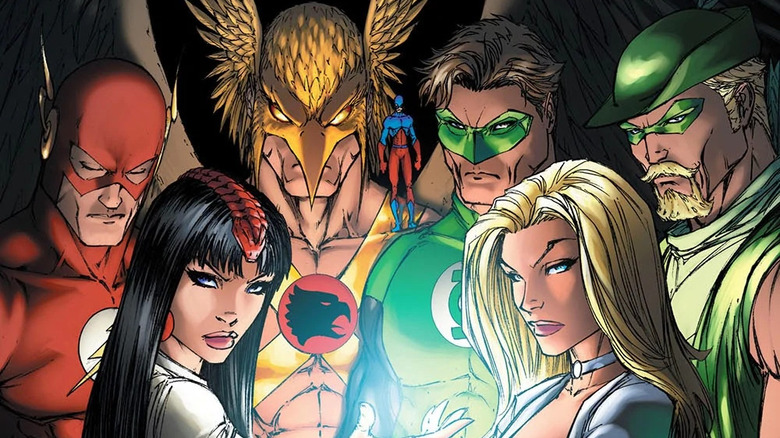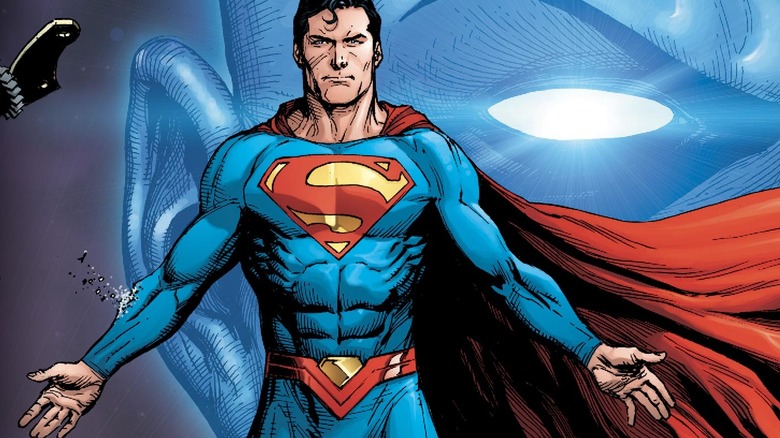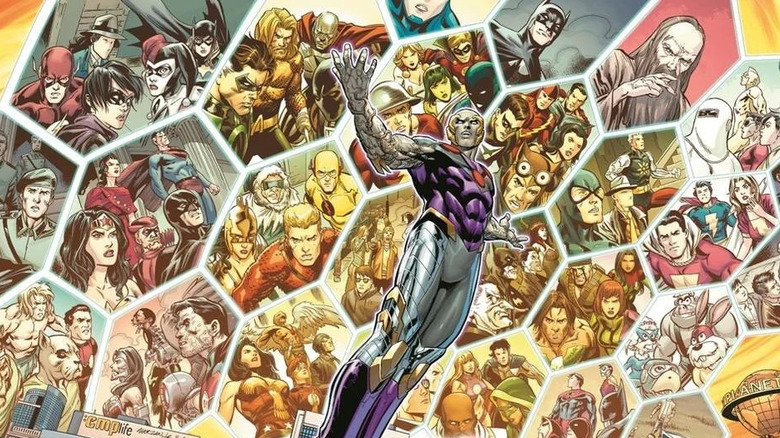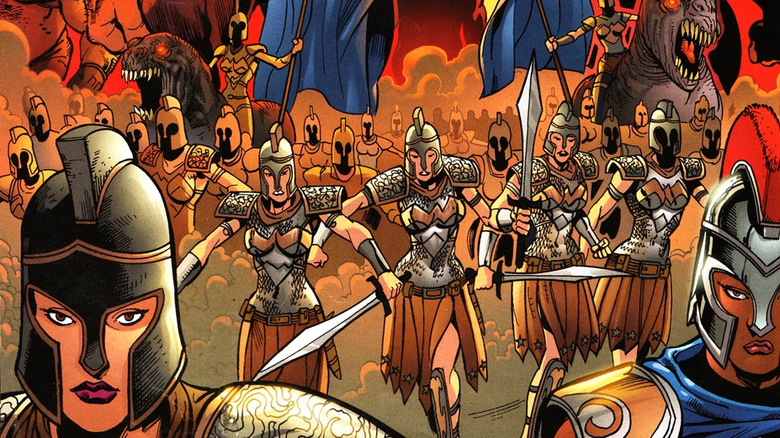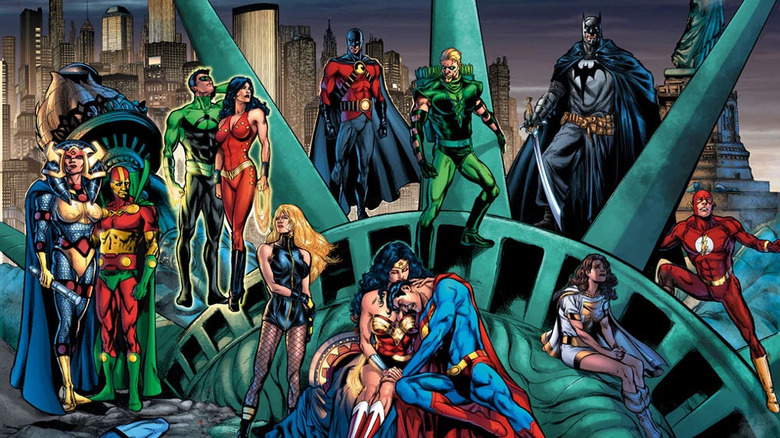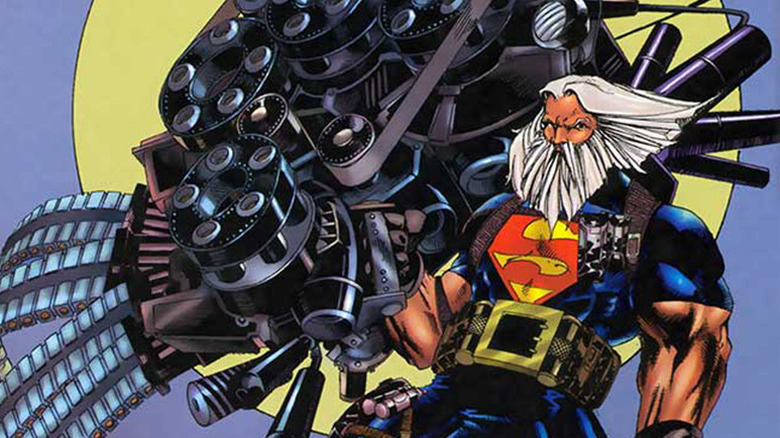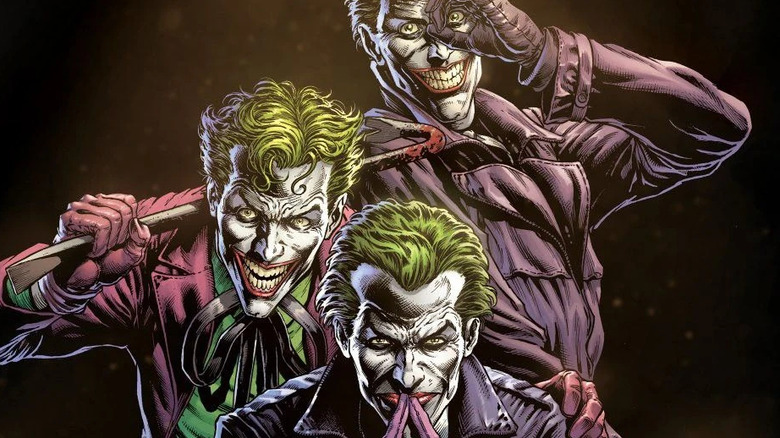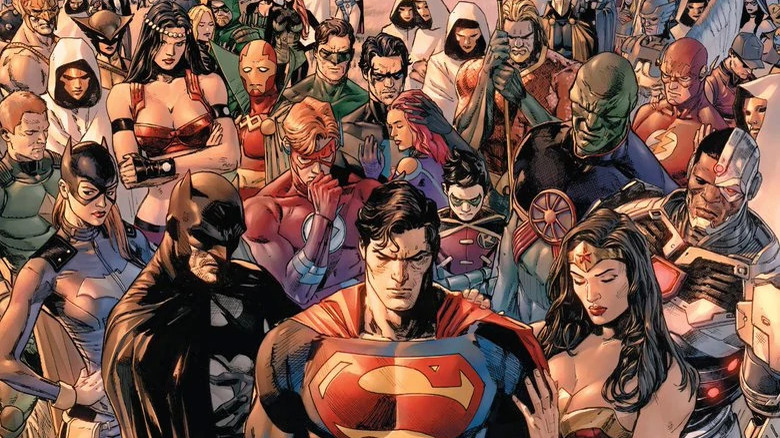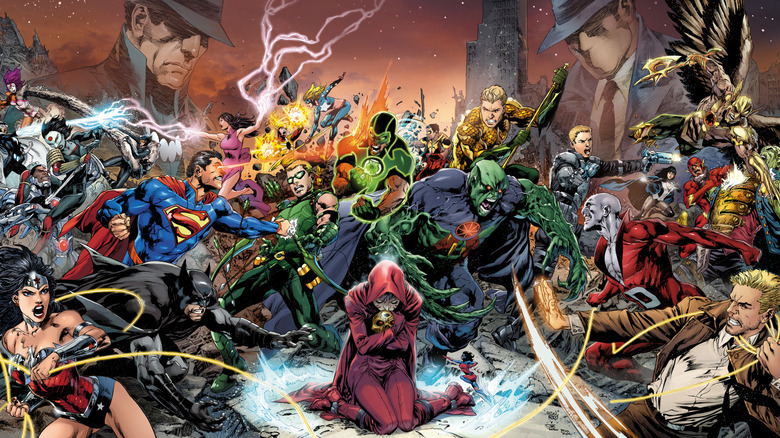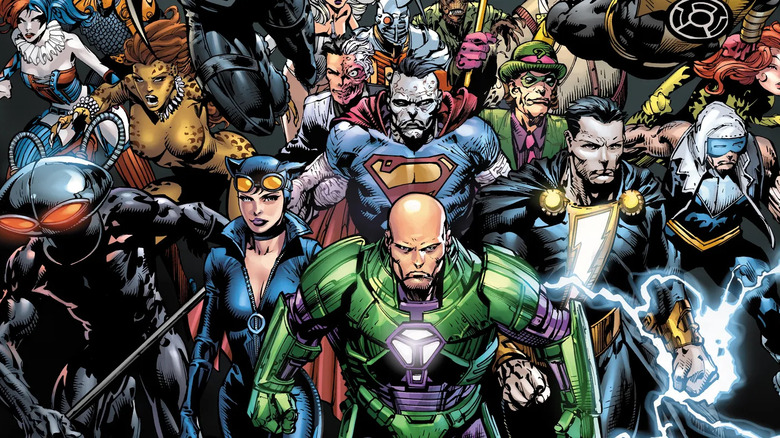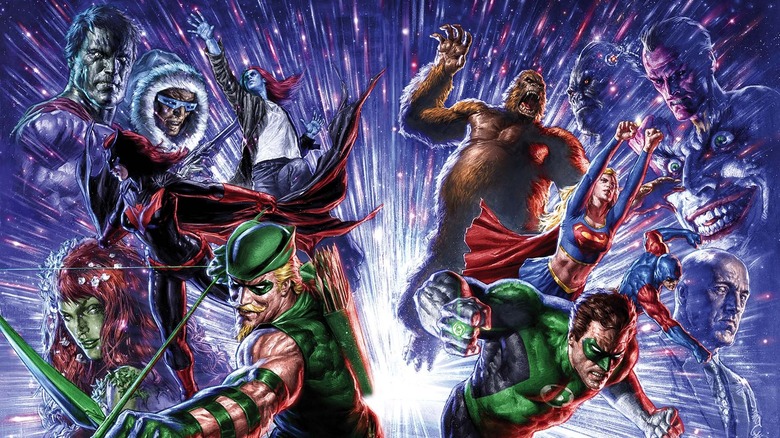12 Stories The DC Cinematic Universe Should Avoid At All Costs
The DC Cinematic Universe is going through a sizable transition phase, and attention has already turned to what stories might be on the slate for future adaptation. The news that James Gunn has been appointed as co-chair of DC Studios alongside Peter Safran (via The Hollywood Reporter) has certainly divided fans. Some are excited to see Gunn's vision play out, while others are annoyed that many aspects of the existing universe have been thrown away — particularly the bombshell news that Henry Cavill has been dismissed from his role as Superman (via IGN).
While he has proven comic book movie directorial experience — for both Marvel and DC — Gunn will need to put his best foot forward if he wants the hardcore fans to embrace his new vision. This means he'll need to be selective in terms of the characters and stories he chooses to bring to the big screen. DC has a long history, rife with ample material. But as with most long-spanning universes, some stories are stronger than others. These are just some of the stories that the DC Cinematic Universe would be wise to avoid.
All Star Batman & Robin, The Boy-Wonder
Perhaps best known for the memes that came out of it, "All Star Batman & Robin, The Boy-Wonder" is widely criticized for being one of Frank Miller's worst comics (via Forbes). Confirming that Miller's best years were most definitely behind him, it is hard to conceive how the man who wrote "The Dark Knight Returns" could stumble and fall this hard in terms of quality. The story was set to achieve the same purpose as "All Star Superman" — a self-contained alternate look at key DC characters — and in this case, Batman and Robin. "All Star Batman & Robin, The Boy-Wonder" looks at some of the early crime-fighting exploits of Gotham's vigilante and his recruitment of the titular sidekick.
While it is a fine idea on paper, sadly this story remains one of the worst interpretations of the Caped Crusader and the Boy Wonder. Despite some great artwork by Jim Lee, the book is hindered by terrible, often cringe-worthy dialogue. One line in particular — culminating in the declaration "I'm the goddamn Batman" — has gained notoriety for all the wrong reasons. Add to that a ridiculous and meandering plot, and the sub-standard characterization of women, and you have all the hallmarks of a total misfire.
Identity Crisis
Few titles have been as divisive among hardcore DC fans as 2004's "Identity Crisis." Many consider it to be an emotional and well-written comic, while others have denounced the writing and the messy storytelling. "Identity Crisis" focuses on the exploits of the Justice League, as they investigate the murder of Sue Dibny, the wife of Ralph Dibny (aka The Elongated Man). As the hunt for the killer becomes a mad frenzy, there are a series of deaths and harsh revelations. One of these pertains to the b-list supervillain, Dr. Light, who is a likely suspect due to his heinous past actions.
It is revealed that Dr. Light sexually assaulted Sue on the Justice League's watchtower, resulting in him having his mind wiped by the League in retaliation. As well as the controversial subject matter, it raises the moral question of whether he should've been allowed to forget what he had done. Ultimately, Dr. Light is not the murderer, and the big reveal of the actual culprit is deeply unsatisfying and makes little sense in the grand scheme of the storyline. Much of "Identity Crisis" seems to be controversial just for the sake of being controversial, and this could prove tricky to navigate in an adaptation.
If you or anyone you know has been a victim of sexual assault, help is available. Visit the Rape, Abuse & Incest National Network website or contact RAINN's National Helpline at 1-800-656-HOPE (4673).
The Doomsday Clock
Few graphic novels have stood the test of time quite like Alan Moore's nihilistic deconstruction of superheroes, "Watchmen." Originally conceived of as a dark reinterpretation of DC's old Charlton Comics characters, "Watchmen" soon became its own unique creation (via TwoMorrows). Through its impactful writing and unforgettable characters, the series has gone on to hold a celebrated position within the medium of comic books. Unfortunately — given the book's immense success — DC Comics has often attempted to capitalize on it in less-than-stellar ways. This includes "The Doomsday Clock" — a late-2010s series penned by Geoff Johns, usually a solid writer especially when it comes to multi-part epics.
Unfortunately, this story is a far cry from his usually entertaining work, instead coming off as forced and unneeded. Simply put, the story sees the world of "Watchmen" collide with the established DC Comics universe, resulting in a thunderous clunk. The plot reveals that the "New 52" Universe that DC had introduced was actually a creation of Doctor Manhattan. While boasting a few interesting ideas, the story is nothing to write home about and certainly not on par with the original "Watchmen." While DC's films might be going in some experimental directions, perhaps it's best if "The Doomsday Clock" never strikes midnight.
Convergence
It's safe to say — especially with the benefit of hindsight — that DC's "New 52" initiative fell very short of its intended mark. When it was first announced that the DC Universe and all of its pre-established continuity were being rebooted, fan reactions were definitely split (via Polygon). While some were intrigued by the fresh start, many weren't keen on having their favorite iterations of characters effectively tossed in the bin. For around five years, the "New 52" limped through life — producing more misses than hits — and leaving many fans underwhelmed.
That same sentiment extended to the event that finally axed off the "New 52" branding for good — the "Convergence" mini-series. The event sees one of Superman's greatest enemies, Brainiac, kidnap the denizens from various DC timelines, placing them in domes on a planet outside of spacetime. While this was a fun concept that led to some enjoyable tie-in books, the event itself was a bore and a far cry from "Crisis on Infinite Earths." Lacking any unique stakes, "Convergence" is another event produced to bait hardcore DC fans with the old characters that they love so dearly. Given the DC Cinematic Universe's issues with logically connecting each film, it might be best to leave any multiverse shenanigans on the back burner for now.
Amazons Attack
Many were saddened when it was announced that DC and Warner Brothers were no longer pursuing a third "Wonder Woman" movie (via Variety). However, being dealt the short straw seems to be an unfortunate recurring aspect of Diana Prince aka Wonder Woman's existence in comics as well as movies. This perhaps isn't helped by the fact she has the distinction of being at the center of one of DC's worst event comics, "Amazons Attack"
Diana was already in the midst of an in-universe controversy, having snapped Maxwell Lord's neck on live television — considered by many to be one of the worst things Wonder Woman has ever done. This leads to Diana's imprisonment and a subsequent invasion of her people — the Amazons of Themyscira — who are led by Diana's mother. Now Diana must withstand a conflict between her own sisters and the people she has sworn to protect.
On a conceptual level, this story definitely had some potential to be good, but sadly fell miles short of that mark. Through a combination of illogical character choices and sloppy writing, the story is more frustrating than it is entertaining. Add to that its placement between "Infinite Crisis" and "Countdown to Final Crisis," and you have the makings of a confusing mess. "Amazons Attack" is a far cry from the best Wonder Woman stories and if DC's symbol of truth ever makes it back to the silver screen, it should be any story but this one.
Countdown to Final Crisis
Following the multiverse-shattering events of "Infinite Crisis," every one of DC's key titles jumped ahead one year, leaving a certain amount of mystery and intrigue about what had happened. So to reveal what had occurred in those missing 365 days, "52" was penned to fill in the gaps.
Through some stellar writing and art, the book was a hit and everyone seemed to love it (via IGN). One exception to the almost universal praise for "52" was DC's editor Dan Didio. In an interview with Ain't It Cool News, writer Mark Waid said Didio, "Would storm up and down the halls telling everyone how much he hated it [52]." He also made a particularly big show about how "Countdown to Final Crisis" was "52 done right." "Countdown" follows the likes of Kyle Rainer, Mary Marvel, Donna Troy, Jason Todd, Jimmy Olsen, and Harley Quinn, and takes a look at the fallout from "Infinite Crisis."
The book set out to fill in DC's missing year and serve as a lead-in for their upcoming event comic, "Final Crisis." Didio may have thought highly of "Countdown to Final Crisis," but it is a story that is often regarded as one of DC's worst event comics (via IGN). In many ways, the story is an egregious mess, filled with inconsistent writing and baffling creative decisions. With James Gunn looking to give the DC Cinematic Universe a much-needed facelift, "Countdown to Final Crisis" is one he should avoid.
Superman: At Earth's End
Have you ever wondered what it'd be like if Superman was The Punisher? If you answered yes to that question, then we have just the title for you. The only problem is, it isn't a very good one. "Superman: At Earth's End" is set in the far-off future of the DC Universe, following the events of "Kamandi: At Earth's End." In this alternate future, mankind has been wiped out and the planet's populace has been replaced by mutated animals and androids. Fighting amongst the chaos is a grizzled older Superman, complete with Rob Liefeld-style muscles, and excessive weaponry.
"Superman: At Earth's End" is a bizarre dark future story offering very little in the way of entertainment — aside from one glorious moment where Superman punches a robot's guts out while screaming "I am a man!" Like many of the more bombastic comic book moments, this line became a meme — boosted by the review by Linkara. It's a story dripping in every trite cliche that '90s comic books became known for, making it an insufferable read. Given the mixed reaction to the dark future presented in Zack Snyder's "Justice League," DC fans likely wouldn't be excited for another portrayal of a grim future.
Batman: Three Jokers
Perhaps more than any other superhero, Batman's rogue's gallery is packed with memorable villains — and none are more widely celebrated than The Joker. However, with this popularity comes the unfortunate side effects of over-saturation. In the last few years alone we've seen on-screen portrayals from Joaquin Phoenix, Jared Leto, and Barry Keoghan. With the glut of Joker content showing no signs of stopping, the publication of "Batman: Three Jokers" seems to make sense.
The comic follows Batman after he learns there are three variants of The Joker — The Criminal, The Clown, and The Comedian. Essentially, this story is intended to account for any inconsistencies in The Joker's in-universe presentation, wherein his behavior and tone frequently changed depending on what story he was in. While the concept is interesting on paper, the result is nowhere near as spectacular as it promised to be. Aside from some solid artwork and a neat twist that retroactively changes the infamous "The Killing Joke," this three-issue story is a bit of a dud. If DC is dead-set on giving us more of The Clown Prince of Crime, there are far better stories out there than "Batman: Three Jokers."
Heroes in Crisis
Comic books have frequently been used to shine a light on various real-world issues, including drug abuse, war, and mental health (via Medium). Despite often being larger-than-life figures, many superheroes are also written to reflect issues that the reader might be facing.
"Heroes in Crisis" centers around The Sanctuary — a secret mental rehab facility set up by the Trinity for heroes and villains. However, a murder mystery plot kicks off when the facility's residents — including Wally West and Roy Harper — are horrifically killed in a mass shooting. This results in Harley Quinn and Booster Gold — the only survivors — becoming the number one suspects in the eventual investigation.
The premise is promising, however, it is later revealed that the incident was accidentally caused by Wally West himself — his grief for his lost family manifesting through the Speed Force. For any fans who'd been amped to see West back after many years, this was a bitter disappointment (via IGN). Additionally, the book's handling of mental health is very muddled, and never quite sure what its overall message is. Loathed by many, "Heroes in Crisis" is one of DC's more frustrating storylines in recent years and not worthy of a big screen adaptation.
Trinity War
Comic book creators seem to have an affinity for events built around large-scale hero versus hero conflicts. On the one hand, seeing the occasional hero-on-hero melee can be a real treat, and the kind of event that provides instant intrigue for fans. However, DC — and Marvel as well — have frequently gone overboard with this concept. In the 2010's in particular, there was an excess of superhero versus superhero narratives in the world of comics.
"Trinity War" sees all three Justice Leagues — the main League, America, and Dark — at each other's throats. This is due — among many other convoluted reasons — to Superman seemingly losing control of his powers. Eventually it's revealed this was all part of the machination of the Crime Syndicate of America — the Justice League's Earth-3 doppelgangers. That's really the biggest issue with the story, as it struggles to operate as a standalone event when it is merely a very elaborate setup for another event entirely, "Forever Evil."
"Trinity War" is a perfect example of how DC needlessly complicates their event comics — a widespread event that affects multiple titles, forcing readers to buy every book associated with it just to understand the full narrative. With James Gunn looking to drastically overhaul DC's creative direction on-screen, drawn out event stories wouldn't make for the best source material — at least to begin with.
Forever Evil
"Forever Evil" is a fairly interesting story, but there are a few major reasons that mean it shouldn't be adapted into a feature film. The story starts with a doozy of a hook: The Justice League are missing, and the sun has been blocked by the moon. This leaves things in the hands of Superman's greatest enemy, Lex Luthor, who must now flip the script and save the world. Luthor and an assortment of other villains have to contend with the Justice League of America's doppelgängers, the Crime Syndicate of America. Throw in some solid twists and you've got an interesting story that uses Lex Luthor in a fascinating way.
However — as with so many of these event comics — "Forever Evil" largely serves as a lead-in for an entirely different DC event, later known as "Darkseid War." With James Gunn's desire to reboot the DC Cinematic Universe, much of the content presented in "Forever Evil" is now sadly unusable. It is a story that is reliant on an established, pre-existing universe, and this is not conducive with Gunn's plan for overhaul. Any attempt to prolong the existence of any previous continuities would likely complicate things. While far from a horrendous event comic, if a fresh new start is what DC needs, then "Forever Evil" is perhaps best left on the shelf for a while.
Justice League: Cry for Justice
When it comes to female character deaths in comic books, few companies have handled it with as little class as DC Comics. From Sue Dibny to Alexandra DeWitt, DC has often had issues with a trope known as "Women in Refrigerators" — writers disposing of female characters to further a male character's narrative. There are subsets to this trope, as it also applies to female characters who get the axe for nothing more than cheap shock value. Nowhere is this trope exemplified clearer — and in a more tasteless fashion — than in "Justice League: Cry for Justice."
The story sees Green Lantern and Green Arrow deciding to quit the Justice League — seeking true justice against the Secret Society of Super Villains. In their quest for justice, the duo and League soon find themselves contending with the supervillain Prometheus — who plans to teleport the hero's home cities through space and time. His first target, Star City, is hit and in the fallout, the body of Roy Harper's (aka Red Arrow) daughter Lian is found in the rubble. It's a loathsome development, one that many fans were immediately repelled by, and it isn't hard to see why. If the DC Cinematic Universe wants to be successful, avoiding divisive creative decisions like this is an absolute imperative.
